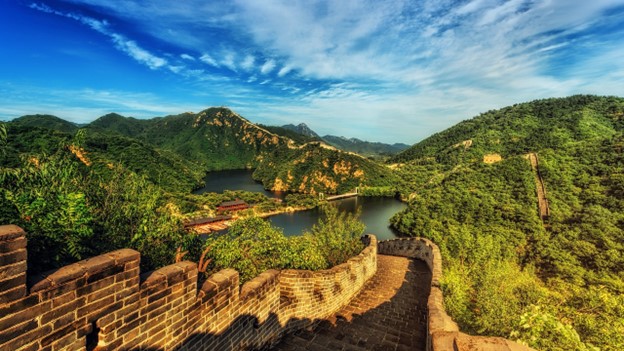The Great Wall of China is a series of fortifications that were built across the historical northern borders of ancient Chinese states and Imperial China as protection against various nomadic groups from the Eurasian Steppe. The Great Wall developed from the disparate border fortifications and castles of individual Chinese kingdoms. For several centuries these kingdoms probably were as concerned with protection from their near neighbors as they were with the threat of barbarian invasions or raids. Rulers during the Ming dynasty (1368–1644) ceaselessly maintained and strengthened the Great Wall to prevent another Mongolian invasion. The majority of the work took place along the old walls built by the Bei Qi and Bei Wei.
The Great Wall of China is an ancient architectural marvel and one of the most iconic structures in the world. It is a massive wall that stretches across the northern part of China, spanning over 13,000 miles (21,196 kilometers) in length. The wall was built over many centuries, with construction beginning as early as the 7th century BC and continuing until the 17th century AD.

The Great Wall of China is long and famous in northern China. It was built a long time ago to protect China from enemies. The wall is made of stones, bricks, and other materials. It has watchtowers and other structures along its length. The wall is important to Chinese history and culture, and it represents the strength and unity of the country. Today, it is a popular tourist attraction.
The Great Wall of China is a symbol of China’s past and a remarkable example of human engineering. The purpose of the Great Wall was defensive, it also served as a symbol of Chinese unity and strength. The wall has played a significant role in Chinese history, culture, and national identity. It also shows the unity and strength between the people, and how they were determined in their time and wanted to preserve their homeland.
Historical Background
The Great Wall of China was constructed over several centuries involving multiple dynasties. The main motive was to protect the country from the enemies. The number of dynasties played a major role in preserving China in the early period.
Qin Dynasty (221-206 BC) The construction of the earliest known iteration of the wall began during the Qin Dynasty. Qin Shi Huang, the first emperor of China, aimed to unify the country and protect it from invasions by northern nomadic tribes, particularly the Xiongnu. Han Dynasty (206 BC-220 AD): The Han Dynasty significantly expanded the Great Wall, especially during the reign of Emperor Wu. Ming Dynasty (1368-1644 AD) The Ming Dynasty played a crucial role in the construction and extensive renovation of the Great Wall. They faced constant threats from the Mongols and other nomadic tribes, leading to a massive effort to strengthen and fortify the wall.
These dynasties played a significant role in ancient times, these rulers were ambitious to protect and preserve the country from the neighboring countries. These actions also show the tranquility and unity between the people.
Cultural and Symbolic Importance
The Great Wall of China is very important to Chinese culture. It represents their history and shows the strength and unity of the country. It has inspired many poems, paintings, songs, and stories. The wall is seen as a symbol of bravery, love for the homeland, and the Chinese people’s determination. It has also influenced military strategies and has become a famous tourist attraction. The number of people visited the Great Wall of China. The Great Wall is a powerful reminder of China’s past and its enduring cultural legacy.
The magnificent Wall of China serves as a vital defensive system, shielding the populace from enemies while demonstrating the might of the various dynasties that contributed significantly to the building of this stunning wall and its subsequent protection. Many people came to this location to see the wall’s beauty, and the wall also piqued their interest in the artwork and the various kinds of stone, bricks, and pillars that were used. Ultimately, defense was the reason the wall was constructed.
ARTICLE BY – PINAL LIMBACHIYA | EDITED BY – SAHIL HARVANI



